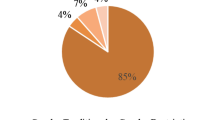Abstract
Although females comprise 51% of the population, they are represented in less than that amount in children's literature. Psychologists and leaders of liberation groups affirm that gender stereotyping in children's books has detrimental effects on children's perception of women's roles. Therefore, illustrated children's books that view women positively can be used to eliminate these stereotypes. Eighty-three Notable Books for Children from 1995 to 1999 were analyzed for gender of main character, illustrations, and title. This research updated LaDow's content analysis method and revealed that contrary to earlier studies, steps toward equity have advanced based on the increase in females represented as the main character (S. LaDow, 1979). Although female representation has greatly improved since the 70s, gender stereotypes are still prevalent in children's literature.
Similar content being viewed by others
REFERENCES
Albers, P. (1996). Issues of representation: Caldecott gold medal winners 1984–1995. The New Advocate, 9, 267-285.
Arbuthnot, M. H. (1984). Children and books. Chicago, IL: Scott Foresman & Company.
Bender, D. L., & Leone, B. (1989). Human sexuality: 1989 annual. San Diego, CA: Greenhaven Press.
Collins, L. J., Ingoldsby, B. B., & Dellman, M. M. (1984). Sex-role stereotyping in children's literature: A change from the past. Childhood Education, 90, 278-285.
Crabb, P. B., & Bielwaski, D. (1994). The social representation of material culture and gender in children's books. Sex Roles, 30, 69-79.
Creany, A. D. (1995). The appearance of gender in award-winning children's books. In selected readings from the Annual Conference of the InternationalVisual Literacy Association (pp. 289-298). Chicago, IL: International Visual Literacy Association.
Crew, H. (1997). How feminist are fractured fairy tales? In Gender and Culture in Picture Books. 1997. [Internet]. “n.p.”: Kay E.Vandergrift. Retrieved September 28, 2000, from http://www.scils.rutgers.edu/special/kay/crew.html
Easley, A. (1973). Elements of sexism in a selected group of picture books recommended for kindergarten use. East Lansing, MI: National Center for Research on Teacher Learning. (ERIC Document Reproduction Service No. ED104559)
Fried, F. J. (1982). Stereotyping in children's materials. East Lansing, MI: National Center for Research on Teacher Learning. (ERIC Document Reproduction Service No. ED215320)
Heintz, K. (1987). An examination of the sex-role and occupational-role presentations of female characters in award-winning children's picture books. Paper presented at the annual meeting of the International Communication Association, Montreal, Quebec, Canada.
Hulme, M. H. (1998). Guidelines for evaluating mathematic books for bias. Columbus, OH: Eisenhower National Clearinghouse. Retrieved September 28, 2000, from <http://www>. enc.org/topics/equity/stories/vignettes/documents/0,1341,ACQ-111549-1549,00.shtm
Kiefer, B. Z. (1995). The potential of picturebooks. Englewood Cliffs, NJ: Prentice Hall.
Kinman, J. R., & Henderson, D. L. (1985). An analysis of sexism in Newbery medal award books from 1977 to 1984. The Reading Teacher, 38, 885-889.
Kortenhaus, C. M., & Demarest, J. (1993). Gender role stereotyping in children's literature: An update. Sex Roles, 28, 219-232.
LaDow, S. (1976). A content-analysis of selected picture books examining the portrayal of sexroles and representation of males and females. East Lansing, MI: National Center for Research on Teacher Learning. (ERIC Document Reproduction Service No. ED123165)
Narahara, M. (1998). Gender stereotypes in children's picture books. East Lansing, MI: National Center for Research on Teacher Learning. (ERIC Document Reproduction Service No. ED419248)
Oskamp, S., Kaufman, K., & Wolterbeek, L. A. (1996). Gender role portrayals in preschool picture books. Journal of Social Behavior and Personality, 11(5), 27-39.
Peterson, S. B., & Lach, M. A. (1990). Gender stereotypes in children's books: Their prevalence and influence on cognitive and affective development. Gender and Education, 2, 185-196.
Roberts, P. (1976). The female image in the Caldecott medal award books. East Lansing, MI: National Center for Research on Teacher Learning. (ERIC Document Reproduction Service No. ED181467)
Scott Foresman & Company. (1972). Improving the image of women in textbooks. Glenview, IL: Scott Foresman & Company.
Shaw, V. (1998). Sexual harassment and gender bias. New York: The Rosen Publishing Group.
Snee, B. (1979). Sexism and ten techniques to combat it through children's books. East Lansing, MI: National Center for Research on Teacher Learning. (ERIC Document Reproduction Service No. ED188168)
Turner-Bowker, D.M. (1996). Gender stereotyped descriptors in children's picture books: Does curious Jane exist in the literature? Sex Roles, 35, 461-488.
Weiller, K. H., & Higgs, C. T. (1989). Female learned helplessness in sports: An analysis of children's literature. Journal of Physical Education, 60, 65-67.
Weitzman, L. J., Eifler, D., Hokada, E., & Ross, C. (1972). Sex-role socialization in picture books for preschool children. American Journal of Sociology, 77, 1125-1150.
Author information
Authors and Affiliations
Corresponding author
Rights and permissions
About this article
Cite this article
Gooden, A.M., Gooden, M.A. Gender Representation in Notable Children's Picture Books: 1995–1999. Sex Roles 45, 89–101 (2001). https://doi.org/10.1023/A:1013064418674
Issue Date:
DOI: https://doi.org/10.1023/A:1013064418674



